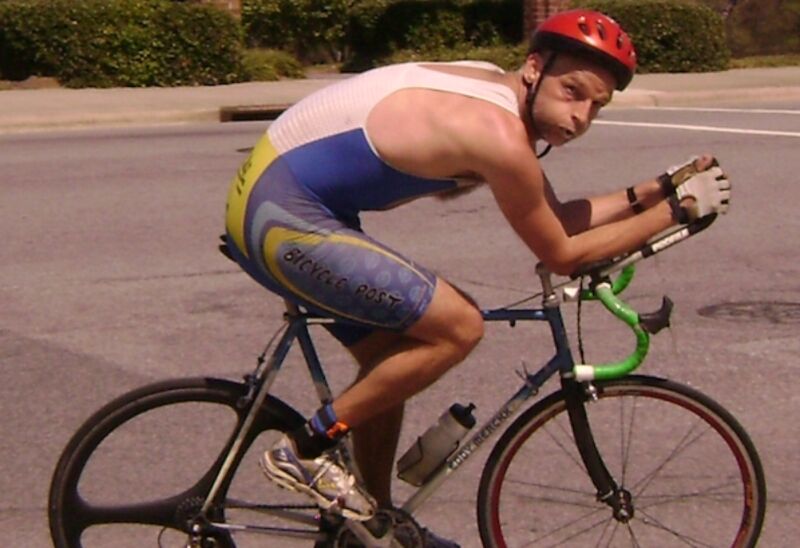
Martin Bier
Many avid bicyclists these days have hopped onto the “everesting” bandwagon, in which one rides up and down the same mountain route over and over until the total distance of one’s ascents matches the elevation of Mount Everest: 8,848 meters or about 5.5 miles. Recently there has been debate over whether a strong tailwind could help a rider improve their time. But apparently that’s not the case, according to a new paper published in the American Journal of Physics by physicist Martin Bier of East Carolina University in North Carolina.
The term “everesting” takes its name from George Mallory, grandson of the legendary 1920s mountaineer George Mallory who participated in the first three British Everest expeditions. Mallory the younger was prepping for his Everest attempt in 1994, and his training included weekend workouts involving bicycling up Mount Donna Buang in Australia many times until he had achieved the elevation of Mount Everest.
Twenty years later, another Australian cycling enthusiast, Andy van Bergen, started organizing worldwide “everesting” events. Participating cyclists would pick a hill near their homes and track each other’s progress online. The events became extremely popular in 2020 after the outbreak of the COVID-19 pandemic sparked global lockdowns.
According to Bier, your average in-shape cyclist generally requires more than 20 hours to complete such a feat, but pros can manage it much faster. For instance, Irish cyclist Ronan McLaughlin completed the challenge in a record time of 7:04:41 on July 30, 2020, breaking his own time on the same hill (Mamore Gap in Ireland) in March 2021 to complete the challenge in 6:40:54.
Bier used McLaughlin’s record-setting rides for his analysis. The route McLaughlin used is an 810-meter segment of road with a 117-meter climb. There wasn’t very much wind for McLaughlin’s first attempt in 2020, but on his second 2021 ride, he had a tailwind of about 12 MPH (20 MPH or 5.5 m/s). Given the marked improvement in his time, there was much “qualitative speculation” in cycling circles about the degree to which the tailwind helped set that “everesting” record, with some pondering whether the rules might need to be changed to limit allowed wind speeds for determining future everesting records.
The bicyclist’s paradox
Bier points out in his paper that the same tailwind would have been a headwind on McLaughlin’s descent; the question, therefore, is whether the strong tailwind effect on climbs was greater than the headwind on descents. There is a concept known as “the bicyclist’s paradox” in physics education circles: if one bikes up a hill and back down, and there is no net change in elevation, one might intuitively expect that the uphill and downhill speeds should cancel out.
But that’s not what happens, largely because of air resistance. Granted, air resistance is a negligible factor when cycling uphill, which is why experienced bicyclists will try to double their power output/speed during climbs. However, the force of air friction increases with the square of one’s speed. One needs four times the power output to double one’s speed, and nine times as much to triple one’s speed. This, says Bier, “wreaks havoc.”
Bier found that while a tailwind might help a little during climbs, the headwind actually has a huge effect during downhill stretches. In fact, going downhill adds about 12 seconds to the lap time because “it takes time to accelerate to the terminal speed.” One might improve one’s everesting time by riding longer laps. For example, if one everested on a hill twice as long as McLaughlin’s Mamore Gap route, one would only make 30 downhill accelerations instead of 76, adding a little over seven minutes to the time. He described the added 12 seconds as simply “the price one pays for a shorter lap.”
For his model, Bier didn’t take into account physiological factors, most notably the fact that McLaughlin’s record-breaking ride involved five-minute laps, with four minutes devoted to climbing and one minute going downhill. “Because of the regular rests, the power output during the four-minute effort is probably higher than an output that could be sustained uninterrupted,” he wrote. “It is likely that there is an optimum time interval if one is to follow each effort with a rest that lasts about a quarter of the time of the effort. The optimum may, moreover, differ from one athlete to another.”
That said, “All in all, changing the everesting rules to set limits on allowed wind speeds is not warranted by the physics,” Bier concluded. “What the control analysis ultimately tells us is that the most intuitive ways towards faster everesting times, i.e., reducing weight and increasing power, are indeed the most effective ways. There are no clever tricks to get around the necessary diet and exercise.”
DOI: American Journal of Physics, 2024. 10.1119/5.0131679 (About DOIs).




















+ There are no comments
Add yours